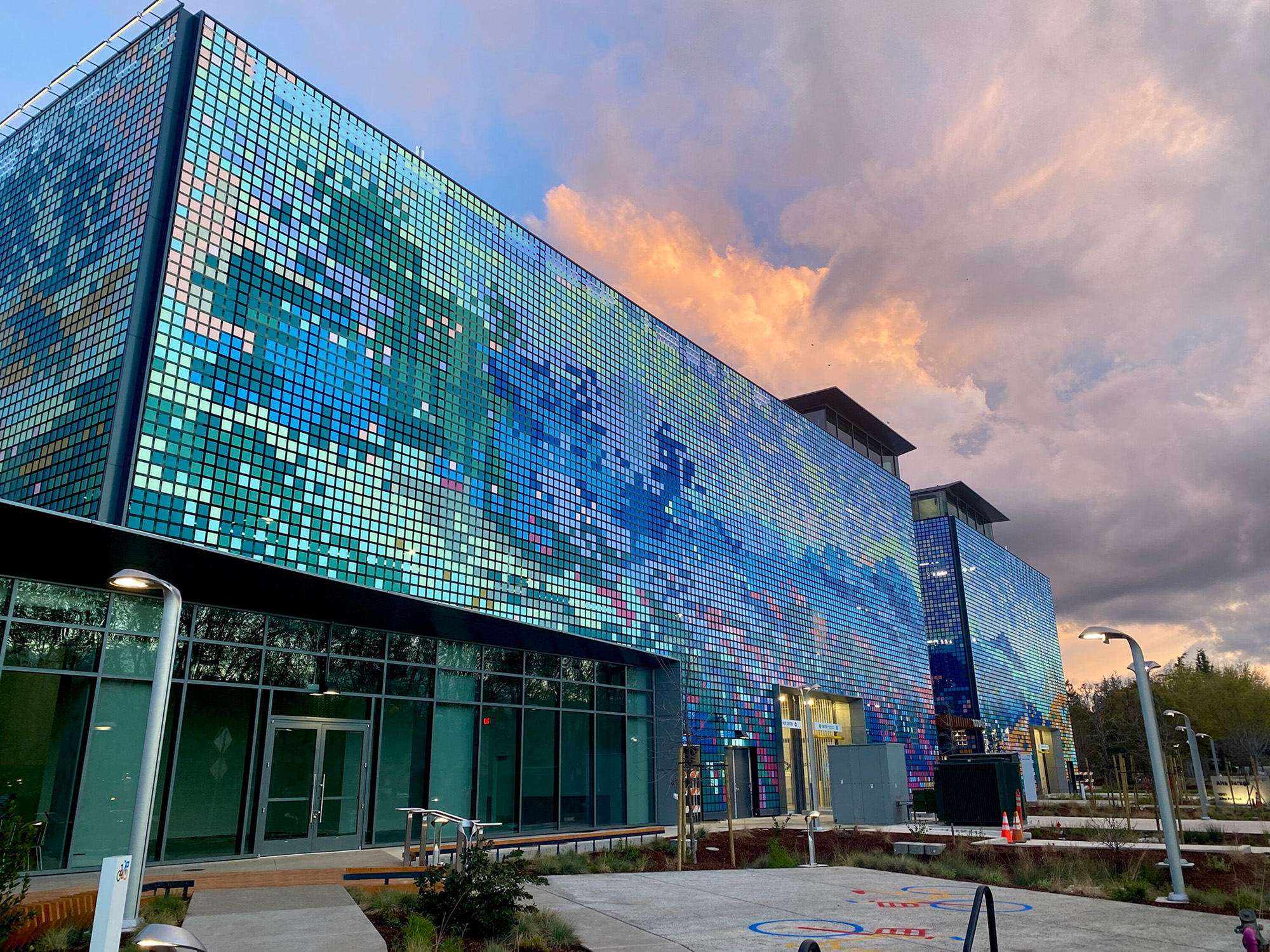A massive, colorful, moving mural creatively conceals a newly opened, four-level, 520,000-sf parking garage for a global technology company in Mountain View, Calif. Linetec finished 111,692 individual metal flappers in 35 different colors to compose the wind-activated KINETICWALL system manufactured by EXTECH/Exterior Technologies, Inc.
The parking structure itself was designed by Gensler and International Parking Design. The building owner commissioned paintings by Los Angeles-based artist Kim West to depict different seasons of Mountain View’s natural landscape. The original artwork was then digitized by art consultant Selbert Perkins Design. For each pixel, Linetec finished an 8-by-8-inch extruded aluminum flapper panel in the corresponding color. To achieve the pixelated mural effect, 35 unique colors were chosen to match West’s original artwork.
When wind passes through the building façade’s KINETICWALL system, the thousands of painted “pixels” within the illustrated landscape move in response. “Kinetics express wind wave patterns as the elements move in sequence from light to dark as they catch light,” explained Kevin Smith, director of product application and development at EXTECH.
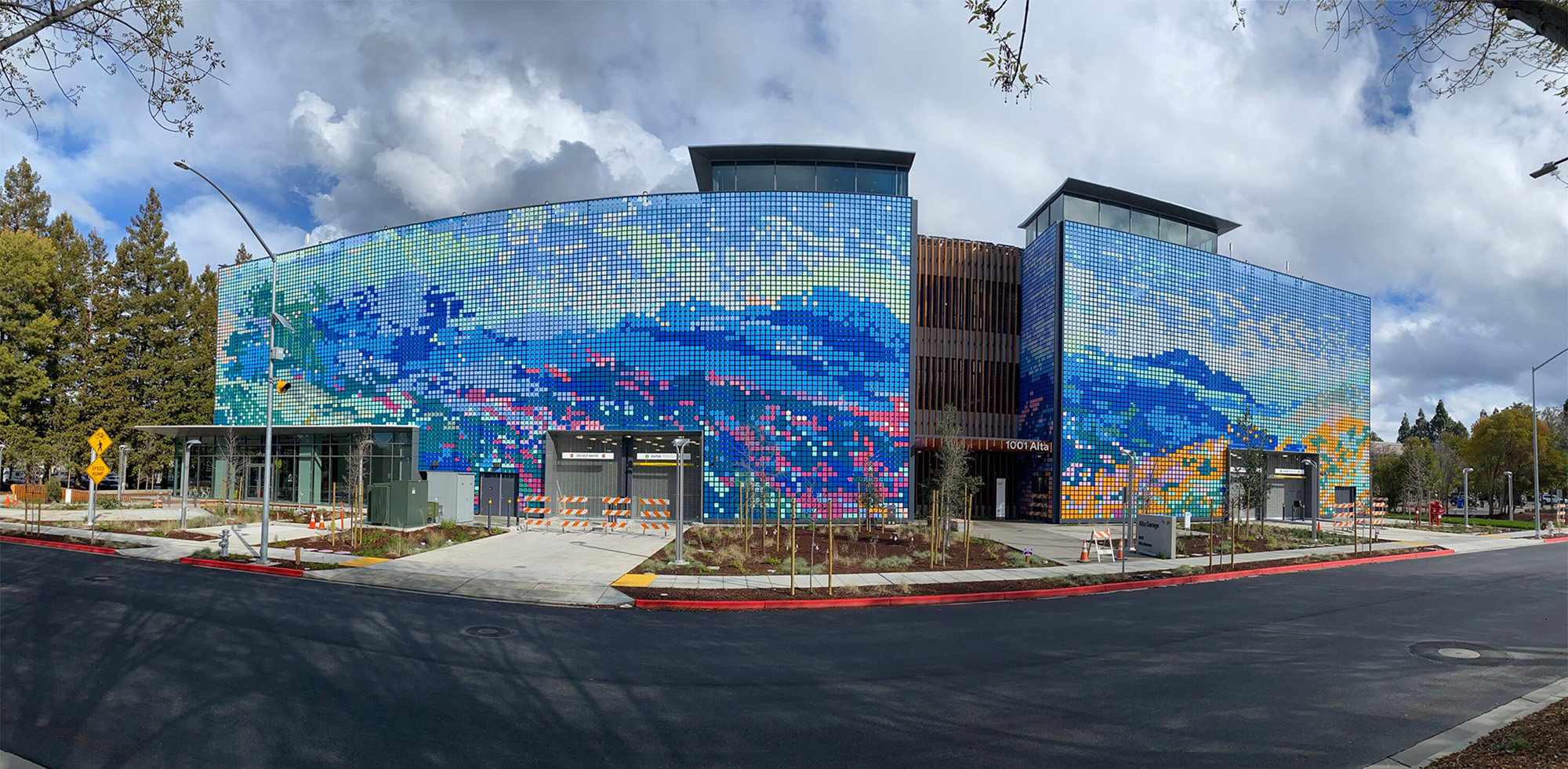
For more than a decade, EXTECH and Linetec have collaborated on successful projects. In 2016, they worked together on the KINETICWALL installation at Boston’s Logan International Airport’s parking garage extension consisting of more than 48,000 anodized aluminum flapper panels.
“EXTECH’s projects with dynamic façade systems are always interesting and exciting,” said Linetec’s director of marketing, Tammy Schroeder. “This California tech company project is definitely one of the most colorful and impressive projects that I can recall Linetec ever doing.” According to EXTECH, it also is the largest KINETICWALL project to be completed in the U.S.
Parking garage mural blends artistry and functionality
As an artist, West selected Pantone colors used in graphic design and printing. To ensure durable, high performance that maintains the intended visual impression and longevity, the color selections were matched in 70% PVDF resin-based architectural coating systems. Linetec meticulously adjusted each paint formulation for approval by EXTECH and West.
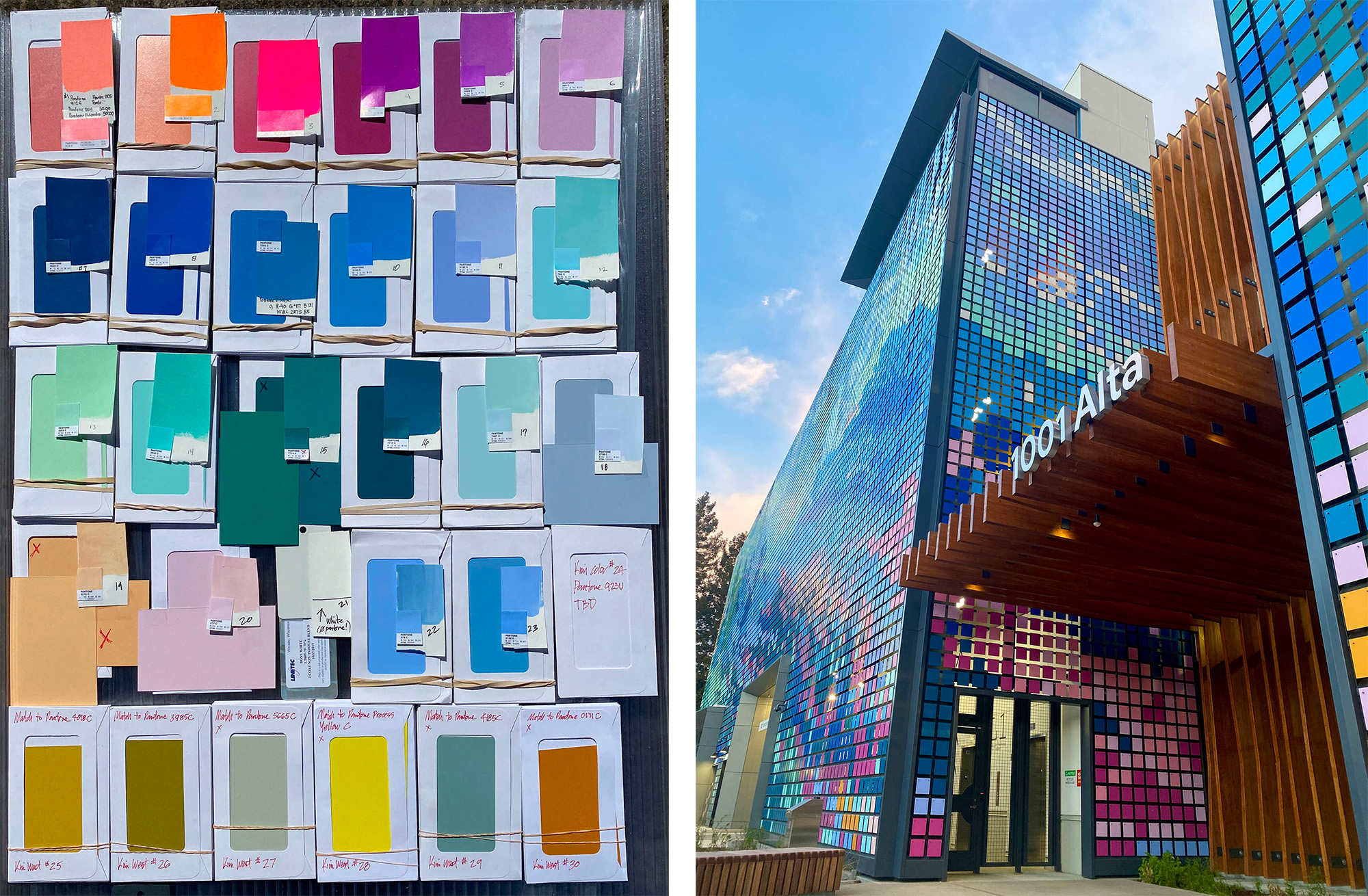
Once all 35 colors were approved, Linetec applied the finish to the designated quantity of metal flapper panels at its Wisconsin-based facility. Specified to meet stringent AAMA 2605 industry standards, 70% PVDF resin-based coatings exhibit outstanding resistance to humidity, color change, chalk, gloss loss and chemicals. These colorful finishes also resist fading under California’s sunny skies and have passed at least 4,000 hours of salt spray testing to demonstrate performance under coastal conditions.
During the design process, EXTECH fabricated four different study mock-ups plus a one-story on-site mock-up to confirm its KINETICWALL system achieved the project’s artistic and performance requirements. Once the order was approved and processed, Linetec finished and shipped the painted aluminum components to EXTECH’S manufacturing headquarters in Pittsburgh for assembly. Each kinetic element was oriented and positioned in place to align with the artist’s vision. The flapper panels are set within extruded aluminum framing support assemblies that span each of the building’s elevations.
EXTECH’s engineering team mapped out where each flapper element would go, color-coordinating and labeling sections to determine where an element would be assembled and ultimately installed by Arrow Sign Company. The project’s entire KINTECWALL system was sequenced and shipped to the jobsite in approximately 90 truckloads to coordinate with the phased installation. Throughout the installation, EXTECH provided detailed as-built drawings for each elevation, on-site inspections and assistance.
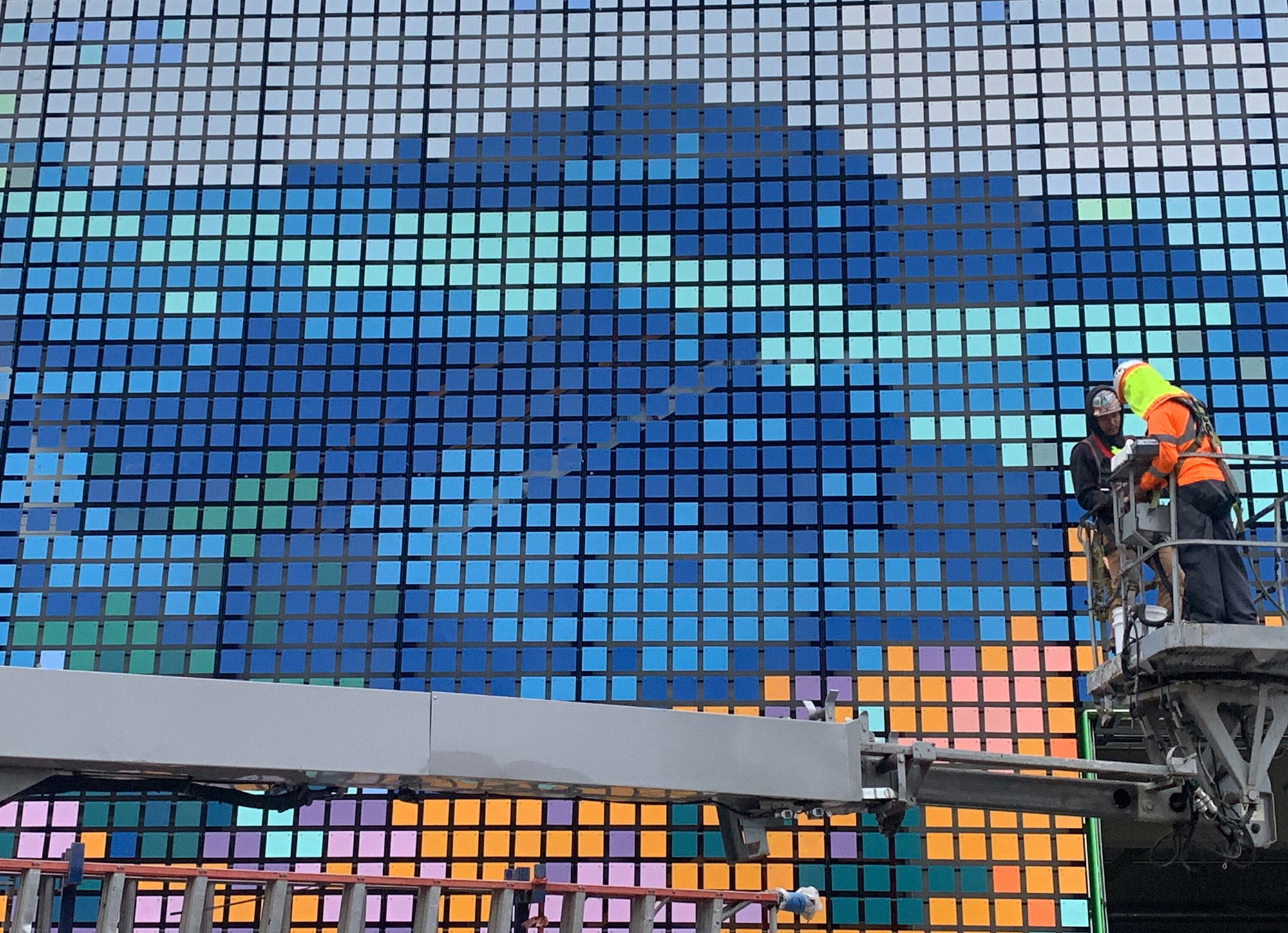
For the Mountain View parking facility project, EXTECH’s KINETICWALL uses a pin-mount suspension system, which allows the flapper elements to seemingly float in front of the support rungs and side rails as a veil. This configuration minimizes the appearance of the supporting structure and is more convenient when creating innovative aesthetic designs.
Along with its distinctive exterior appearance, the KINETICWALL provides a functional façade for shading and ventilating the parking structure, and offers visibility from the interior. The flapperwall’s pin-mount suspension, lightweight aluminum and unitized construction also facilitates installation, saving time and labor in the field. Each flapper element was mounted in pre-assembled “ladder and rung” panels. The dimensions of these unitized panels spanned more than 22 feet tall by 6 feet 8 inches wide.
Toward the bottom of the wall, up to 9 feet above grade, static flappers are manufactured with thicker gauge metal and mounted in a custom rung system. Together with stainless steel mesh, this project-specific design helps deter climbing on the exterior and vandalism from the interior. Pin-mount suspension systems allow the flappers to be removed and replaced without any specialized tools if repair or maintenance is needed. Linetec’s high-performance finishes further minimize the need for maintenance and maximize longevity.
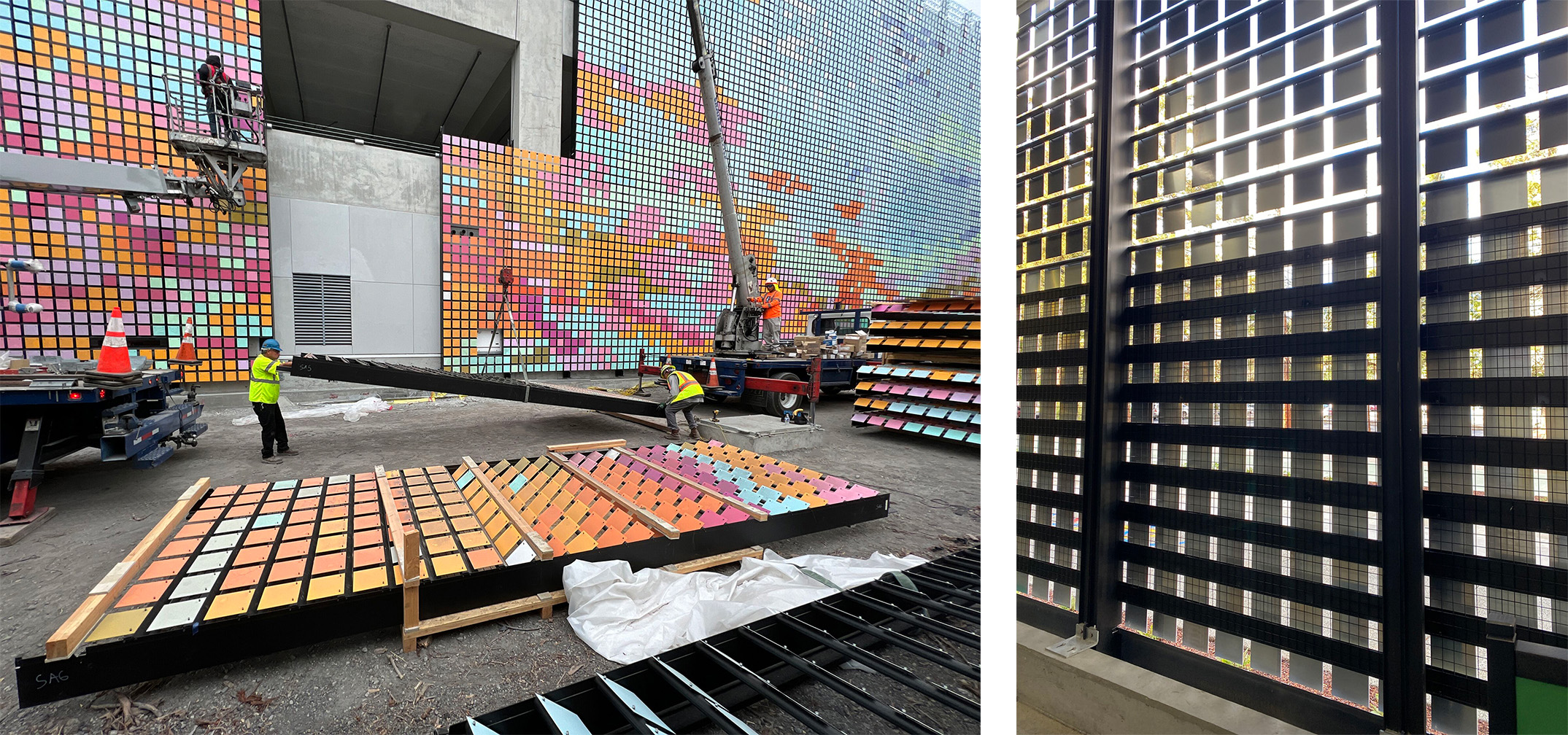
Future-proofing for current and adaptive reuse
According to Clark-Pacific, the building owner sought to “future-proof” its capital investment by considering a 50-year operational outlook. “As a result, the project team was able to design and construct a parking structure that fulfills present requirements, while allowing for the flexibility to repurpose the building in the future. The structure was intentionally designed to facilitate adaptive reuse, enabling it to transform from a garage into an office building with minimal selective demolition, while preserving the overall structure and some of the existing systems.”
Currently, the building comprises 1,209 static parking stalls and 460 mechanical stackers. Clark-Pacific described the facility, noting, “Its tall ceiling heights and painted interior create a spacious and bright environment for users, and its dynamic exterior boasts a kinetic façade that replicates murals of the surrounding environment. Additionally, a pedestrian greenway connects the site to other areas on the campus, and the building includes extensive landscaping and user amenities, such as a 1-megawatt solar structure and 10,000 sf of retail space on the first level.”
“The unique, colorful, dynamic façade demonstrates how visual beauty and innovative technology can be combined to form a result where the whole is more impressive than the sum of its parts,” concluded Schroeder.
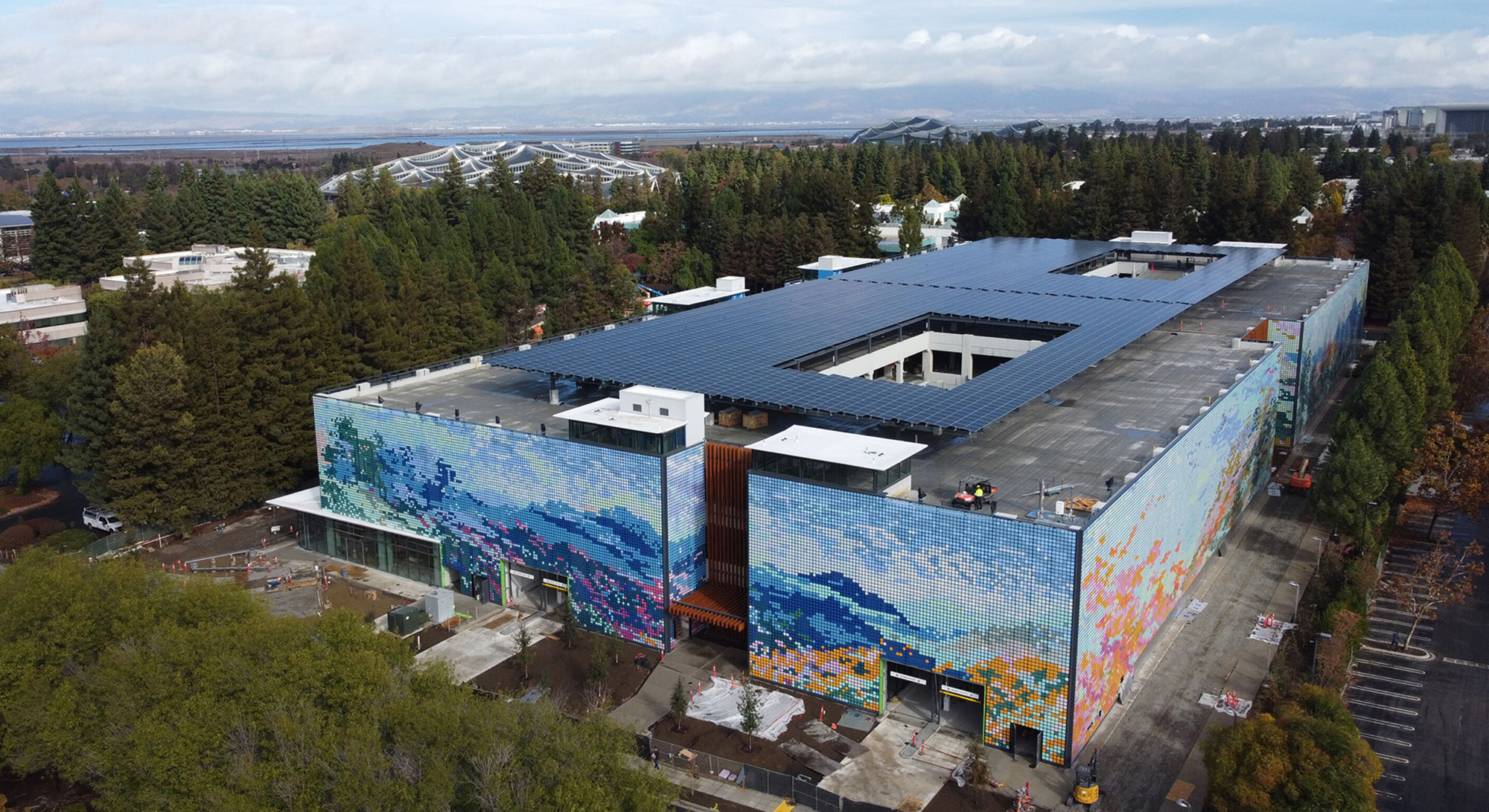
On the Building Team
Architects: Gensler, International Parking Design, Inc.
Mural Artist: Kim West
Engineer/Manufacturer – Façade System: EXTECH/Exterior Technologies, Inc.
Finishing Services – Façade System: Linetec
GC: Clark-Pacific
Related Stories
| Jun 2, 2014
Parking structures group launches LEED-type program for parking garages
The Green Parking Council, an affiliate of the International Parking Institute, has launched the Green Garage Certification program, the parking industry equivalent of LEED certification.
| May 29, 2014
7 cost-effective ways to make U.S. infrastructure more resilient
Moving critical elements to higher ground and designing for longer lifespans are just some of the ways cities and governments can make infrastructure more resilient to natural disasters and climate change, writes Richard Cavallaro, President of Skanska USA Civil.
| May 20, 2014
Kinetic Architecture: New book explores innovations in active façades
The book, co-authored by Arup's Russell Fortmeyer, illustrates the various ways architects, consultants, and engineers approach energy and comfort by manipulating air, water, and light through the layers of passive and active building envelope systems.
| May 19, 2014
What can architects learn from nature’s 3.8 billion years of experience?
In a new report, HOK and Biomimicry 3.8 partnered to study how lessons from the temperate broadleaf forest biome, which houses many of the world’s largest population centers, can inform the design of the built environment.
| May 13, 2014
19 industry groups team to promote resilient planning and building materials
The industry associations, with more than 700,000 members generating almost $1 trillion in GDP, have issued a joint statement on resilience, pushing design and building solutions for disaster mitigation.
| May 11, 2014
Final call for entries: 2014 Giants 300 survey
BD+C's 2014 Giants 300 survey forms are due Wednesday, May 21. Survey results will be published in our July 2014 issue. The annual Giants 300 Report ranks the top AEC firms in commercial construction, by revenue.
| Apr 29, 2014
USGBC launches real-time green building data dashboard
The online data visualization resource highlights green building data for each state and Washington, D.C.
Smart Buildings | Apr 28, 2014
Cities Alive: Arup report examines latest trends in urban green spaces
From vertical farming to glowing trees (yes, glowing trees), Arup engineers imagine the future of green infrastructure in cities across the world.
| Apr 9, 2014
Steel decks: 11 tips for their proper use | BD+C
Building Teams have been using steel decks with proven success for 75 years. Building Design+Construction consulted with technical experts from the Steel Deck Institute and the deck manufacturing industry for their advice on how best to use steel decking.
| Apr 2, 2014
8 tips for avoiding thermal bridges in window applications
Aligning thermal breaks and applying air barriers are among the top design and installation tricks recommended by building enclosure experts.


